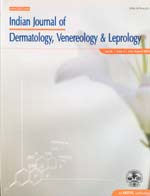
|
Indian Journal of Dermatology, Venereology and Leprology
Medknow Publications on behalf of The Indian Association of Dermatologists, Venereologists and Leprologists (IADVL)
ISSN: 0378-6323
EISSN: 0378-6323
Vol. 70, No. 5, 2004, pp. 292-295
|
 Bioline Code: dv04100
Bioline Code: dv04100
Full paper language: English
Document type: Research Article
Document available free of charge
|
|
|
Indian Journal of Dermatology, Venereology and Leprology, Vol. 70, No. 5, 2004, pp. 292-295
| en |
Study - A study of skin disorders in patients with primary psychiatric conditions
Kuruvila Maria, Gahalaut Pratik, Zacharia Asha
Abstract
BACKGROUND:
The skin occupies a powerful position as an organ of communication and plays an important role in socialization throughout life. The interface between dermatology and psychiatry is complex and of clinical importance.
AIMS:
To document the incidence of cutaneous disorders in patients with primary psychiatric conditions.
METHODS:
Three hundred patients with a primary psychiatric condition who had cutaneous disease were entered into the study group. The patients were classified appropriately based on the classification of psychocutaneous disorders. The control group included 300 patients presenting with a skin disorder and without any known psychiatric complaint.
RESULTS:
The majority of the cases in the study group were in the 3rd-5th decade. In this study, the most common primary psychiatric conditions were manic depressive psychosis (53.33%), depression (36.33%), schizophrenia (8.33%) and anxiety (2%). Of the study group, 68.66% patients had infective dermatoses and the rest had non-infective dermatoses. A high incidence of pityriasis versicolor and dermatophyte infections was noted in males from the study group. Among non-infective dermatoses, 8% had eczema, and psychogenic skin disorders were seen in 4.67% of the study group. Of these, delusions of parasitosis were the commonest (2%) followed by venereophobia (1%).
CONCLUSIONS:
A statistically significant higher incidence of tinea versicolor and dermatophyte infections was seen in the study group. Delusion of parasitosis was the most common psychogenic skin disorder seen in the study group, followed by venereophobia.
Keywords
Psychocutaneous disorders, Delusions of parasitosis, Venereophobia
|
| |
© Copyright 2004 Indian Journal of Dermatology, Venereology, Leprology.
Alternative site location: http://www.ijdvl.com
|
|
